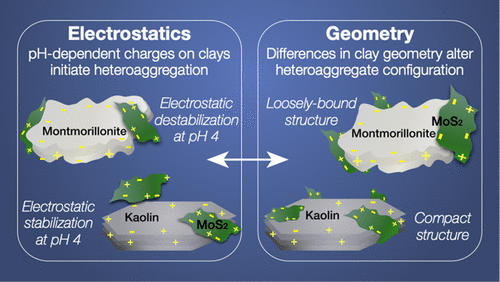当前位置:
X-MOL 学术
›
Environ. Sci. Technol.
›
论文详情
Our official English website, www.x-mol.net, welcomes your
feedback! (Note: you will need to create a separate account there.)
Role of Electrostatics in the Heterogeneous Interaction of Two-Dimensional Engineered MoS2 Nanosheets and Natural Clay Colloids: Influence of pH and Natural Organic Matter
Environmental Science & Technology ( IF 10.8 ) Pub Date : 2020-11-10 , DOI: 10.1021/acs.est.0c03580 Indu Venu Sabaraya 1 , Hyunjung Shin 1 , Xintong Li 2 , Rushmia Hoq 3 , Jean Anne C. Incorvia 2 , Mary Jo Kirisits 1 , Navid B. Saleh 1
Environmental Science & Technology ( IF 10.8 ) Pub Date : 2020-11-10 , DOI: 10.1021/acs.est.0c03580 Indu Venu Sabaraya 1 , Hyunjung Shin 1 , Xintong Li 2 , Rushmia Hoq 3 , Jean Anne C. Incorvia 2 , Mary Jo Kirisits 1 , Navid B. Saleh 1
Affiliation

|
Few-layered molybdenum disulfide (MoS2) nanosheets are poised to be at the core of low-voltage electronic device development. Upon environmental release, these two-dimensional (2D) structures can interact with abundant natural geocolloids. This study probes the role of dimensionality in modulating the aggregation behavior of 2D MoS2 nanosheets with plate-like geocolloids (i.e., homoionized kaolinite and montmorillonite clays). MoS2 nanosheets were exfoliated using an ethanol/water mixture, and aggregation kinetics were investigated with time-resolved dynamic light scattering at low monovalent salt concentrations and at three pH levels, in the presence and absence of Suwannee River humic acid (SRHA). Results indicate that pH and particle ratios are key to modulating the stability of MoS2/clay systems. At pH 4, aggregation of MoS2 increased with increasing MoS2/clay ratios and approached maximum values of 0.09 and 0.06 nm/s in the binary systems with montmorillonite and kaolinite, respectively. Electrostatic attraction facilitates heteroaggregation at pH values of 4 and 6; differences in the clay structures (i.e., face–face or face–edge aggregates) might explain the resulting MoS2/clay aggregate configurations, which were probed via the evolution of particle size distribution. The presence of only 0.1 mg/L SRHA drastically suppresses the heteroaggregation propensity of MoS2 nanosheets with geocolloids (to less than 0.01 nm/s at all pH values tested). The high stability of these heterogeneous systems under environmentally relevant conditions can increase the likelihood for cellular uptake and long-distance transport of MoS2.
中文翻译:

静电在二维工程MoS 2纳米片和天然粘土胶体的异质相互作用中的作用:pH和天然有机物的影响
很少有几层二硫化钼(MoS 2)纳米片准备成为低压电子设备开发的核心。在释放环境后,这些二维(2D)结构可以与大量的天然胶体相互作用。这项研究探讨了尺寸在调节具有板状地质胶体(即均化高岭石和蒙脱土)的2D MoS 2纳米片的聚集行为中的作用。硫化钼2使用乙醇/水混合物将纳米片剥落,在存在和不存在Suwannee River腐殖酸(SRHA)的情况下,在低一价盐浓度和三个pH值下,通过时间分辨动态光散射研究聚集动力学。结果表明,pH和颗粒比是调节MoS 2 /粘土系统稳定性的关键。在pH 4下,MoS 2的聚集随着MoS 2 /粘土比率的增加而增加,并且在分别与蒙脱石和高岭石的二元体系中达到接近0.09和0.06 nm / s的最大值。静电吸引促进了pH值为4和6时的杂聚;粘土结构(即面-面或面-边集料)的差异可能解释了产生的MoS2 /粘土聚集体构型,其通过粒度分布的演变来探测。仅0.1 mg / L SRHA的存在会极大地抑制具有胶体胶的MoS 2纳米片的杂聚倾向(在所有测试的pH值下均低于0.01 nm / s)。这些异构系统在与环境相关的条件下的高稳定性可能会增加细胞摄取和MoS 2进行长距离运输的可能性。
更新日期:2021-01-19
中文翻译:

静电在二维工程MoS 2纳米片和天然粘土胶体的异质相互作用中的作用:pH和天然有机物的影响
很少有几层二硫化钼(MoS 2)纳米片准备成为低压电子设备开发的核心。在释放环境后,这些二维(2D)结构可以与大量的天然胶体相互作用。这项研究探讨了尺寸在调节具有板状地质胶体(即均化高岭石和蒙脱土)的2D MoS 2纳米片的聚集行为中的作用。硫化钼2使用乙醇/水混合物将纳米片剥落,在存在和不存在Suwannee River腐殖酸(SRHA)的情况下,在低一价盐浓度和三个pH值下,通过时间分辨动态光散射研究聚集动力学。结果表明,pH和颗粒比是调节MoS 2 /粘土系统稳定性的关键。在pH 4下,MoS 2的聚集随着MoS 2 /粘土比率的增加而增加,并且在分别与蒙脱石和高岭石的二元体系中达到接近0.09和0.06 nm / s的最大值。静电吸引促进了pH值为4和6时的杂聚;粘土结构(即面-面或面-边集料)的差异可能解释了产生的MoS2 /粘土聚集体构型,其通过粒度分布的演变来探测。仅0.1 mg / L SRHA的存在会极大地抑制具有胶体胶的MoS 2纳米片的杂聚倾向(在所有测试的pH值下均低于0.01 nm / s)。这些异构系统在与环境相关的条件下的高稳定性可能会增加细胞摄取和MoS 2进行长距离运输的可能性。











































 京公网安备 11010802027423号
京公网安备 11010802027423号